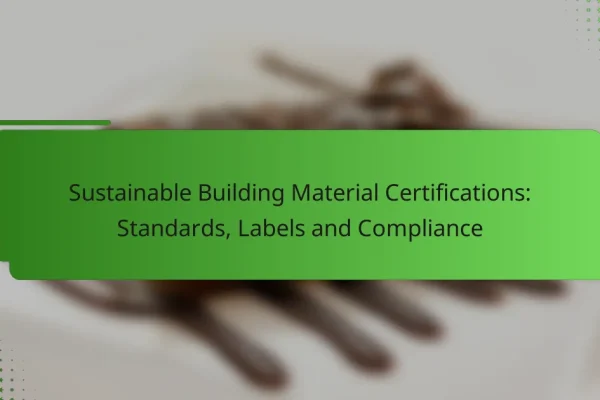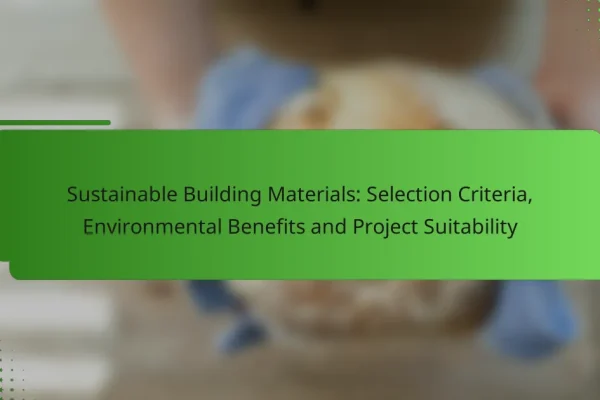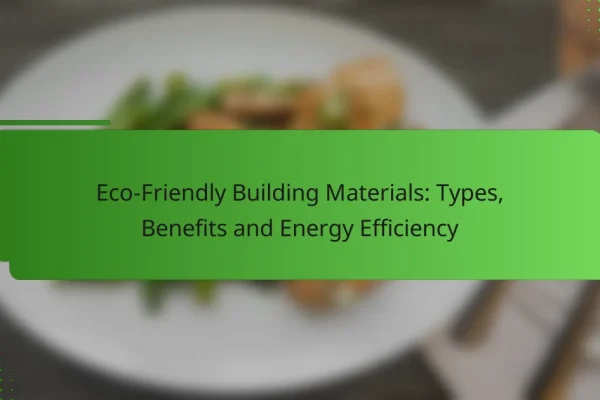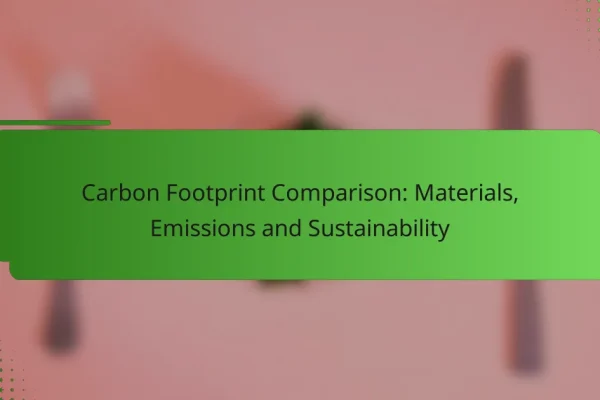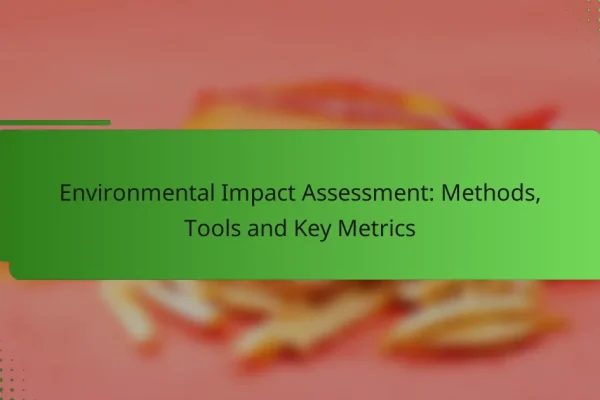How can sustainable building supplies reduce environmental impact?
Sustainable building supplies significantly lower environmental impact by minimizing resource depletion, reducing emissions, and promoting recycling. By choosing materials that are renewable, recycled, or have a lower carbon footprint, builders can contribute to a healthier ecosystem.
Lower carbon footprint
<pUsing sustainable building supplies helps lower the carbon footprint of construction projects. Materials such as bamboo, reclaimed wood, and recycled steel require less energy to produce and transport compared to traditional materials. For instance, opting for locally sourced materials can further reduce transportation emissions.
<pWhen selecting materials, look for certifications like FSC (Forest Stewardship Council) for wood products, which ensures responsible forestry practices. This choice not only supports sustainability but also often results in a more durable and long-lasting structure.
Reduce waste generation
<pSustainable building practices focus on reducing waste generation during construction and renovation. By using materials that are designed for reuse or recycling, builders can significantly cut down on landfill contributions. For example, modular construction techniques allow for precise material usage, minimizing off-cuts and excess.
<pIncorporating a waste management plan that includes recycling and composting can further enhance sustainability. Builders should consider donating leftover materials to local charities or organizations that can repurpose them, thus extending their lifecycle.
Enhance energy efficiency
<pSustainable building supplies often enhance energy efficiency, leading to lower utility bills and reduced environmental impact. Insulation materials like cellulose or sheep's wool provide excellent thermal performance, helping to maintain comfortable indoor temperatures with less energy consumption.
<pIn addition, energy-efficient windows and doors can significantly reduce heating and cooling demands. When selecting these products, look for those with ENERGY STAR ratings, which indicate superior energy performance. Investing in energy-efficient systems may have a higher upfront cost but typically results in savings over time.
What are the best sustainable building materials available?
The best sustainable building materials include bamboo, recycled steel, and hempcrete. These materials not only reduce environmental impact but also offer durability and efficiency in construction.
Bamboo as a renewable resource
Bamboo is a highly renewable resource that grows rapidly, making it an excellent choice for sustainable building. It can reach maturity in just a few years, compared to traditional hardwoods that take decades. This fast growth rate allows for a continuous supply without depleting forests.
When using bamboo, consider its strength-to-weight ratio, which is comparable to steel. It is ideal for structural applications, flooring, and even furniture. However, ensure that the bamboo is sourced from sustainable plantations to avoid contributing to deforestation.
Recycled steel for durability
Recycled steel is a strong and durable building material that significantly reduces the need for new metal production. Using recycled steel can cut energy consumption by up to 75% compared to producing new steel. This material is ideal for framing, roofing, and other structural components.
When selecting recycled steel, check for certifications that confirm its recycled content. Additionally, consider the local availability of recycled steel to minimize transportation emissions. This can often lead to cost savings as well, as recycled materials are typically less expensive than new ones.
Hempcrete for insulation
Hempcrete is a sustainable insulation material made from hemp fibers and lime. It offers excellent thermal performance, helping to regulate indoor temperatures and reduce energy costs. Hempcrete is lightweight and can be used in various construction methods, including infill for timber frames.
While hempcrete is not a load-bearing material, it provides effective insulation and moisture regulation. Ensure that the hemp used is sourced from local farms to support regional agriculture and reduce transportation impacts. Additionally, check for local building codes regarding the use of hempcrete in construction projects.
How to choose sustainable building supplies for your project?
To choose sustainable building supplies, prioritize materials that minimize environmental impact while meeting your project’s needs. Look for certifications, assess lifecycle impacts, and consider sourcing options that support local economies.
Assess material certifications
Material certifications indicate that products meet specific environmental and health standards. Look for labels such as FSC (Forest Stewardship Council) for wood products or LEED (Leadership in Energy and Environmental Design) for overall building materials.
Research the certifications relevant to your region, as they may vary. For example, in Europe, the CE mark indicates compliance with EU safety and environmental regulations.
Evaluate lifecycle impacts
Understanding the lifecycle impacts of building materials involves assessing their environmental footprint from extraction to disposal. Consider factors like energy consumption during production, transportation emissions, and end-of-life recyclability.
Use tools like Life Cycle Assessment (LCA) to compare materials. For instance, concrete has a high carbon footprint due to cement production, while bamboo is often more sustainable due to its rapid growth and renewability.
Consider local sourcing options
Sourcing materials locally can significantly reduce transportation emissions and support the local economy. Check for suppliers within a reasonable distance from your project site to minimize the carbon footprint associated with shipping.
Local materials often have a lower environmental impact and can enhance the aesthetic appeal of your project by reflecting regional styles. For example, using locally quarried stone or timber can create a unique character while being more sustainable.
What are the benefits of using eco-friendly construction products?
Using eco-friendly construction products offers numerous advantages, including improved health outcomes and environmental protection. These sustainable materials often lead to better indoor air quality, long-term cost savings, and increased property value.
Improved indoor air quality
Eco-friendly construction products are typically made from natural materials that emit fewer volatile organic compounds (VOCs). This results in cleaner air within buildings, reducing the risk of respiratory issues and allergies among occupants.
For instance, low-VOC paints and finishes can significantly enhance indoor air quality. Homeowners should look for products that meet established standards, such as Green Seal or GREENGUARD certifications, to ensure safety and effectiveness.
Long-term cost savings
Investing in eco-friendly materials can lead to substantial long-term savings. While the initial costs may be higher, these products often require less maintenance and have greater durability, which can lower repair and replacement expenses over time.
Energy-efficient insulation and windows, for example, can reduce heating and cooling costs by up to 30%. Homeowners should consider the total cost of ownership rather than just the upfront price when selecting sustainable materials.
Enhanced property value
Properties built or renovated with eco-friendly materials often see an increase in market value. Buyers are increasingly seeking homes that are energy-efficient and environmentally responsible, making these features attractive selling points.
In many regions, homes with sustainable certifications can command a premium price. Homeowners should highlight eco-friendly features in listings and consider obtaining certifications to further boost property appeal and value.
How does sustainable building contribute to LEED certification?
Sustainable building practices significantly enhance a project’s eligibility for LEED certification by focusing on environmental stewardship and resource efficiency. By integrating sustainable materials and energy-efficient systems, builders can earn credits that contribute to their overall LEED score, ultimately leading to a more sustainable and responsible construction process.
Materials and resources credit
The materials and resources credit in LEED certification emphasizes the use of sustainable building materials that minimize environmental impact. This includes sourcing materials locally to reduce transportation emissions and selecting products with recycled content or those that are rapidly renewable.
To maximize credits, builders should consider using certified wood products, low-VOC paints, and materials that have a lower life-cycle impact. Keeping a detailed inventory of materials and their sources can help in tracking compliance and achieving the necessary credits.
Energy and atmosphere credit
The energy and atmosphere credit focuses on optimizing energy performance and reducing greenhouse gas emissions. Projects can earn credits by implementing energy-efficient systems, such as high-performance HVAC units, energy-efficient lighting, and renewable energy sources like solar panels.
To effectively achieve these credits, it is crucial to conduct energy modeling during the design phase to identify potential savings. Regular monitoring and verification of energy performance post-construction can also help maintain compliance and improve overall energy efficiency.
What are the challenges in sourcing sustainable building supplies?
Sourcing sustainable building supplies presents several challenges, primarily due to cost, availability, and regulatory considerations. These factors can complicate the decision-making process for builders and contractors aiming to use eco-friendly materials.
Higher upfront costs
One of the main challenges in sourcing sustainable building supplies is the higher upfront costs associated with these materials. Eco-friendly products often require advanced manufacturing processes or premium raw materials, leading to prices that can be significantly higher than conventional options.
For instance, sustainable wood products may cost 20-30% more than standard lumber. While these costs can be offset by long-term savings in energy efficiency and durability, initial investments can deter some buyers.
Limited availability in certain regions
Limited availability of sustainable building supplies can pose a significant challenge, especially in remote or rural areas. Many eco-friendly materials are produced in specific regions, making them less accessible to builders in other locations.
For example, bamboo and reclaimed wood may be readily available in certain markets but scarce in others. Builders should research local suppliers and consider alternative materials that meet sustainability standards while being more accessible.
How can technology improve sustainability in building supplies?
Technology enhances sustainability in building supplies by optimizing resource use, reducing waste, and promoting eco-friendly materials. Innovations such as advanced manufacturing processes, smart materials, and digital tools enable builders to make more sustainable choices throughout the construction lifecycle.
Smart Materials
Smart materials adapt to environmental changes, improving energy efficiency and reducing the need for additional resources. For instance, phase-changing materials can store and release thermal energy, helping to maintain comfortable indoor temperatures without excessive heating or cooling.
Using smart materials can lead to significant energy savings over time. Builders should consider integrating these materials into their designs to enhance sustainability while also meeting performance standards.
3D Printing
3D printing in construction allows for precise material usage, minimizing waste and enabling the creation of complex structures that traditional methods may not achieve. This technology can utilize recycled materials, further enhancing sustainability.
Builders can benefit from reduced labor costs and shorter construction times with 3D printing. However, they should evaluate the initial investment against long-term savings and sustainability goals.
Building Information Modeling (BIM)
BIM is a digital representation of a building’s physical and functional characteristics, allowing for better planning and resource management. It helps identify potential issues early in the design phase, reducing costly changes and material waste during construction.
Implementing BIM can lead to more efficient project delivery and improved collaboration among stakeholders. Builders should invest in training and tools to fully leverage BIM’s capabilities for sustainable outcomes.
Energy Management Systems
Energy management systems monitor and control energy use in buildings, helping to optimize consumption and reduce carbon footprints. These systems can provide real-time data, enabling quick adjustments to improve efficiency.
Integrating energy management systems can result in significant cost savings and enhanced sustainability. Builders should consider these systems as part of their overall strategy to achieve energy efficiency and comply with local regulations.







